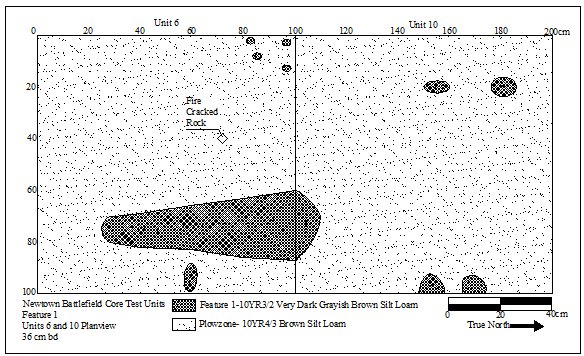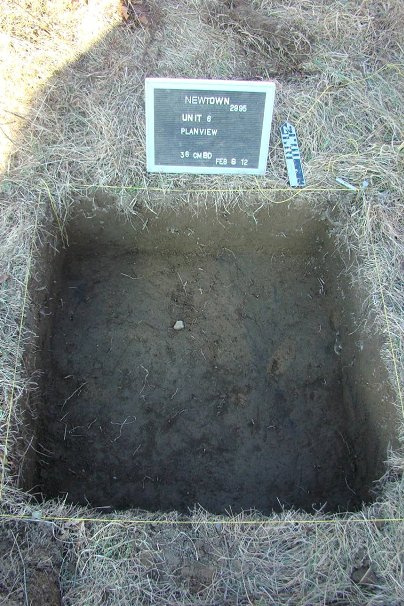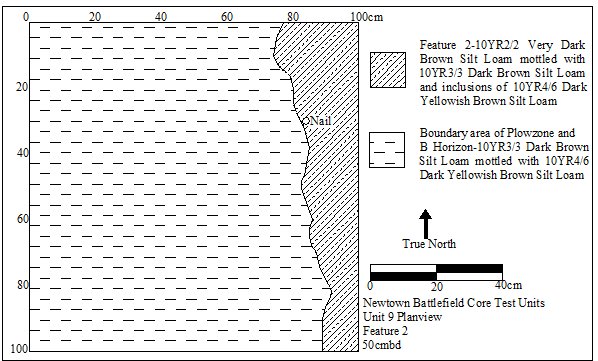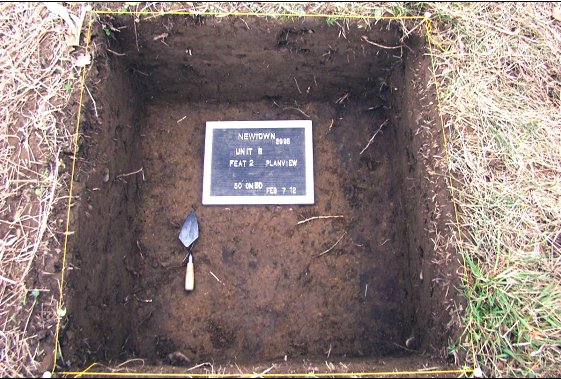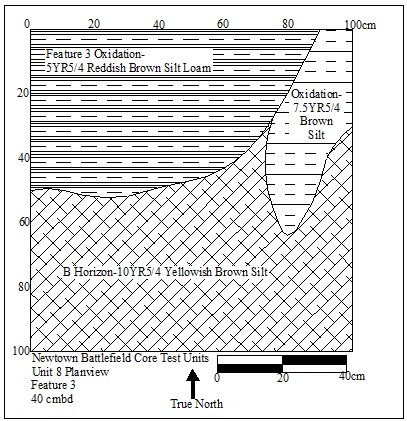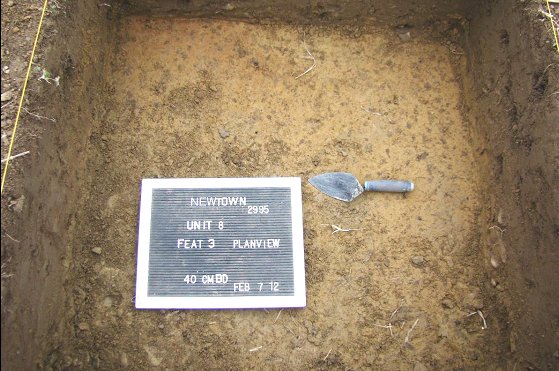VII. Results of Archeological Testing
[text deleted] The primary goal of artifact recovery was to retrieve battle related material. However, the areas surveyed and excavated overlapped with both prehistoric and historic occupations. Non-battle related items were for the most part left in the fields. Items that were specifically related to the Battle of Newtown or their affiliation could not be determined in the field, were collected for analysis in the lab. The definite battle related items included lead fragments, lead musket balls, and lead buckshot. The items with no specific historic affiliation included buttons, buckles, tableware, and undiagnostic metal items. The items did not have a historic affiliation since they did not have enough diagnostic attributes to ascertain affiliation. For the purpose of analysis, the indeterminate items will be included in the analysis of battle related items. As this report is focused on the Battle of Newtown, the non-battle related items will not be discussed, but will be included in the final artifact catalog (Appendix 2.2, p. 99).
Table 5. This table was intentionally deleted per the requirements of the Archaeological Resource Protection Act (16 U.S.C. 470hh) and its implementing regulations (49 FR 1027, Jan. 6, 1984).
Field crews also identified a large collection of modern metal refuse related to farming activities, such as aluminum cans, pie tins, farm machinery parts, and assorted tools. The modern refuse was collected and weighed to illustrate the amount of material present in the fields. The modern refuse may have masked historic and battle related items. Photo 9 provides a visual approximation of the amount of modern refuse collected. The collected modern refuse weighed a total of 64 kg (141 lbs). The amount of modern refuse was consistent for all the test areas. [text deleted]
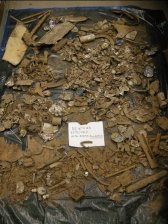
7.1 Battle Related and Indeterminate Artifacts
The battle related and indeterminate artifacts recovered from the metal detector survey fall into two main categories-arms and personal/domestic. The arms consisted of lead balls and buckshot and were gauged to be battle related. The non-armament artifacts were more indeterminate as to their association with the battle and reflect domestic activities that could be related with either personal activities or camp life. The items were also indeterminate due to their use in non-military contexts and lack of diagnostic attributes.
7.1.1 General Artifacts
Five buttons and one cuff link were recovered that could be associated with the battle (Photo 11). Three of the buttons were copper and two were pewter. The cuff link was copper. None of the buttons had designs or decoration that could be associated with military uniforms. Manufacturing dates of the buttons were based on Olsen (1963). The shank types suggest that the buttons date primarily to the late 18th century. [text deleted] The cuff link had no diagnostic attributes and could not be identified as to time period or function. The four full buttons were all coat buttons based on their size. A basket weave design [text deleted] was the only identifiable decoration; the other buttons were most likely covered with cloth, which has decayed. These buttons represent general clothing types from the late 18th century.
The lack of military motifs and designs does not necessarily mean that these buttons are not related to the battle. The frontier nature of the battle meant that many of the combatants may not have had formal uniforms. They may have worn their civilian coats into battle, if they were not supplied coats. This may have been the case for Native American warriors, who as allies and not regular troops would have supplied their own clothing or uniforms.
The recovered buckles were more indeterminate in their association than buttons. Five buckles, three copper and two iron, were recovered (Photo 12). None of the buckles were identifiable as to time period manufactured or use. A fragment of a possible late 18th century copper shoe buckle was identified [text deleted]. As it was so fragmentary, it could not definitively be identified.
Other items were either too fragmentary or lacking in diagnostic attributes to clearly associate the material to the battle. The five utensil or knife fragments were unidentifiable as to time period or function and so could not be clearly associated with the battle. One copper coin *** was so deteriorated that none of the text was legible or images discernible. It measured 2.8 cm (1.1 in) in diameter. A mouth harp [text deleted] (Photo 13) may have been a trade item or may have belonged to one of the battle's combatants, but it may have also been related to a 19th century farmer. One piece of metal recovered from Butler's Depot appeared to be a frizzen from a musket or pistol. However, it was so deteriorated that it could not confidently be identified as a frizzen. Six lead fragments were also recovered that were too fragmented or misshapen to determine their function. These may be the partial remains of fired shot, but could not be confirmed. One piece of lead recovered from the swamp was identifiably melted. No other artifacts or features were found in association with it. It may have pooled on the ground during a melting process. It has the same weight as a rifle ball (14.6 g- allowing for a 0.55" diameter ball). Another lead piece appears to have been a possible source of lead for producing musket or rifle balls *** (Photo 14). It is generally round with no deliberate shape, but has a hole cut into the center. The sides of the hole have evidence of wear, possibly from a leather strap. These items are more likely related to the battle.
[text deleted]
Figure 14. This page/map was intentionally deleted per the requirements of the Archaeological Resource Protection Act (16 U.S.C. 470hh) and its implementing regulations (49 FR 1027, Jan. 6, 1984).
Figure 15. This page/map was intentionally deleted per the requirements of the Archaeological Resource Protection Act (16 U.S.C. 470hh) and its implementing regulations (49 FR 1027, Jan. 6, 1984).
Figure 16. This page/map was intentionally deleted per the requirements of the Archaeological Resource Protection Act (16 U.S.C. 470hh) and its implementing regulations (49 FR 1027, Jan. 6, 1984).
Figure 17. This page/map was intentionally deleted per the requirements of the Archaeological Resource Protection Act (16 U.S.C. 470hh) and its implementing regulations (49 FR 1027, Jan. 6, 1984).
7.1.2 Lead Ball Analysis
Crews recovered a total of 17 lead balls and buckshot [text deleted] Diameters of the buckshot and balls were calculated to better identify the type of weaponry used to fire them. The analysis presented here is based on Sivilich's (2005) equation to determine the diameter of a musket or rifle ball to approximate calibers- Diameter in inches = 0.223304 x (Weight in grams)1/3 (Sivilich 2005). The determination of diameter based on weight is useful as fired lead balls often become so highly deformed after hitting an object that determination of diameter based on caliper measurements is not accurate. However, it is assumed that a fired ball does not lose mass and so its weight can be used to determine its original diameter.
Table 6. This table was intentionally deleted per the requirements of the Archaeological Resource Protection Act (16 U.S.C. 470hh) and its implementing regulations (49 FR 1027, Jan. 6, 1984).
Figure 18. This page/map was intentionally deleted per the requirements of the Archaeological Resource Protection Act (16 U.S.C. 470hh) and its implementing regulations (49 FR 1027, Jan. 6, 1984).
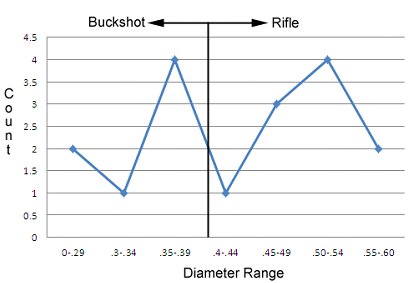

Based on the diameters of the lead ball and buckshot recovered, there are two main identifiable weapon types, buckshot and rifle (Figure 19; Table 7, above). The presence of buckshot is not surprising as General Washington ordered the use of buck and ball cartridges in 1776 (Babits 1998: 13). This included the use of one musket ball loaded with 3 buckshot balls. The purpose was to increase the chances of hitting an object. It allowed the musket to fire in a similar way as a shotgun, with the musket ball firing in a standard way and the buckshot creating a spread fire. Since it was based on musket balls, the usefulness of this type of firing was at close range, since muskets had limited accuracy beyond 50 yards (Babits 1998: 12-15). The presence of buckshot on the Newtown Battlefield along with the extensive use of muskets by both British and Continentals throughout the war suggests that musket balls should have been present in association with the Newtown Battlefield. However, there were no clearly identifiable musket balls recovered.
The lack of musket balls may have been due to post battle disturbance activities. As musket balls are larger than rifle balls, collectors may have more readily seen and collected musket balls due to their size and left the smaller rifle balls and buckshot. This seems to have been the case with artillery as many local residents recounted family histories of their ancestors or relatives collecting "cannon balls." The smaller rifle balls may have been harder to detect in the soil and so were passed over by collectors. The presence of buckshot, but not musket balls, further suggests that size may be a factor as areas where buckshot was recovered should have some musket balls given the type of musket loading used.
[text deleted]
It may be that rifles were more prominent in the battle than muskets. British forces for the most part used Brown Bess muskets and rejected the use of rifles. The British did make very limited use of the Ferguson Rifle and the British Pattern 1776 Rifle. However, the British allied warriors and Loyalist rangers probably had increased access to rifles. The British did supply British allied warriors with weapons (Glatthaar and Martin 2007; Graymont 1972; Williams 2005), however, warriors also relied on their personal weapons, including rifles acquired by trade or raiding. There are accounts of British allied warriors taking rifles from Jagar riflemen following the Siege of Fort Stanwix (Watt 2002: 254, 258). Butler's Rangers also were not well supplied by the British. Governor Guy Carleton specifically states in his marching orders that led to the formation of Butler's Rangers that "Non Commissioned Officers in proportion, the whole to cloath and arm themselves at their own expense" (Haldiman Papers 1777). Major John Butler was given 100 muskets on loan from Fort Niagara's stores in 1779, but Governors Carleton and Haldiman were emphatic that Major John Butler and his rangers supply themselves out of their own pay and not rely on the British stores (Salmon 2009: 329-339). The lack of government supply and the nature of ranger fighting meant that Butler's Rangers probably made use of rifles and due to costs personal hunting rifles (Cruikshank 1893: 59). The Continentals did have rifle contingents in the Battle of Newtown (Morgan's Rifle Corps and Schott's Independent Rifle Corps), but still relied heavily on muskets as the main weapon.
The use of rifles versus muskets during the Revolutionary War was based on formal strategies and tactics. Success in battle during the 18th century, as with all combat, relied on discipline and the ability to control the battlefield. To accomplish this, in the 18th century, strategy was based on the creation of a widespread scattering of musket and lead ball into the opposition's firing line. A high amount of fired lead would lead to a high number of the opposing side's troops being hit. The goal was primarily to inflict death and injury among the enemy's forces, but also to create fear and instability among enemy troops that would lead to the failure of discipline and the enemy's formations, allowing for control of the field. Accuracy was not necessary for such a strategy to succeed. The musket was the preferred weapon, although it only had an accuracy range of about 50 to 80 yards (Babits 1998: 12-15). Rifles had an accuracy range of 300 to 500 yards (Babits 1998: 12-15). This would indicate that rifles would be the preferred gun. However, British regular forces were hesitant to use rifles due to the perceived advantages of muskets (Babits 1998: 13-14).
The musket had numerous advantages over the rifle. Rifles were custom made and so were more expensive to produce and maintain than muskets (Babits 1998: 14-16). Bayonets could not be attached to rifles, which became a major impediment during hand-to-hand combat (Babits 1998: 15). Most importantly, muskets had a firing and reloading cycle that was three times faster than rifles (Babits 1998: 13-14). Muskets were more successful at fulfilling the strategy of producing a wall of fired lead than rifles. The addition of buck and ball loading to muskets further allowed a high amount of fired lead across a firing line. Buck and ball refers to the use of 3-4 buckshot loaded with a musket ball. The numbers show the difference in the amount of fired lead. A soldier could reload and fire a musket three times in a minute versus reloading and firing a rifle once a minute. This would lead to three times as much lead ball being fired by musket fire than by rifle. With buck and ball the number increases to about 12 times the amount of lead being fired by muskets than by rifles. Babits (1998: 14) states that a Continental line of 60 troops could fire 240 projectiles in a single volley using the buck and ball method. In an open field of battle, the effect could be decimating to the opposition's line.
The Battle of Newtown, however, was not fought on an open field of battle. The landscape offered numerous obstacles and coverage features, such as Baldwin Creek, glacial ridges, swamps, and woods. Wooded areas limited the movements and ability to keep the linear troop formations that were standard for the 18th century musket/bayonet strategies and tactics (Babits 1998: 16-17). The combatants, specifically the British forces, were also well practiced in fighting with frontier strategies that required groups with limited numbers to effectively use the landscape to overcome larger forces. In the situation of closed terrain, and greater distance, and alternative strategies and tactics, rifles became effective in overcoming the advantages of musket fire.
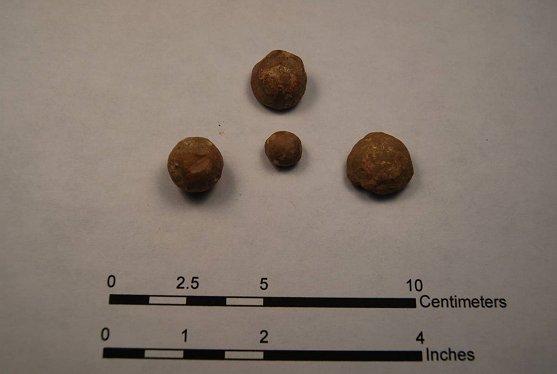
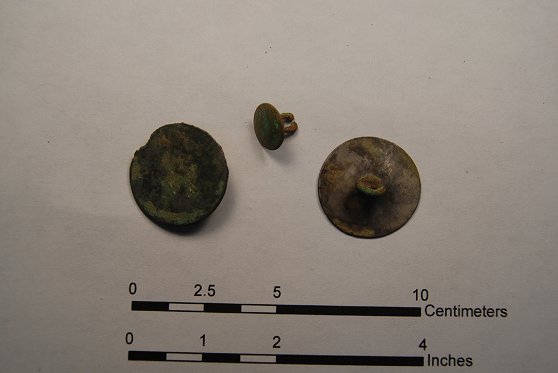
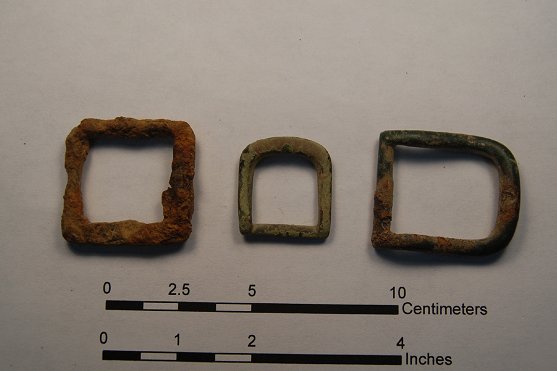
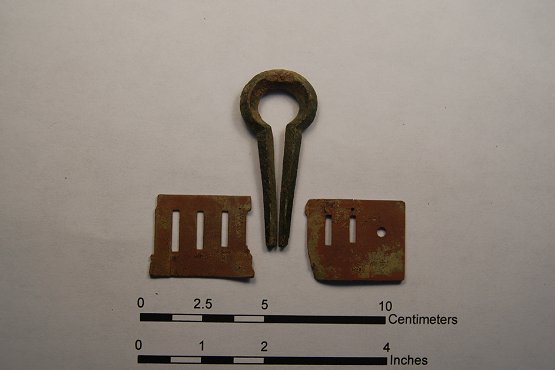
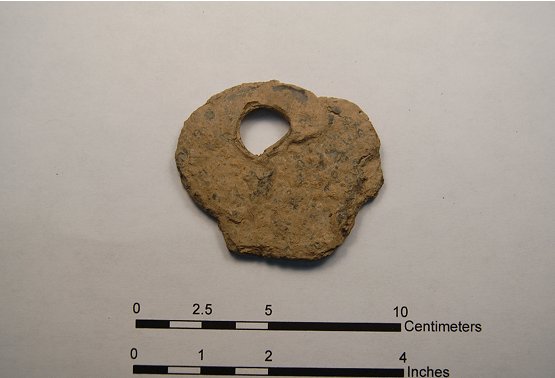
7.2 Test Unit Stratigraphy
The ten test units have a relatively uniform stratigraphy that is common for plowed fields in the region (Appendix 2.1). [text deleted]
The first horizon was identified as a plowed (Ap) soil horizon or plow zone. It was a brown (10YR3/3) silt loam. [text deleted] The intact horizon was similar to the plow zone, but had a higher amount of gravel and rock. The B soil horizon was a yellowish brown (10YR5/4) silt. The plow zone generally ranged in depth from 20 to 30 cm (8 to 12 in) and had an average depth of 24.8 cm (9.8 in). The intact A horizon depths ranged from 25 to 51 cm (10 to 20 in) below the surface. The final depths of unit excavation ranged from 36 to 64 cm (14 to 25 in) below the surface with an average ending depth of 45 cm (18 in) below the surface.
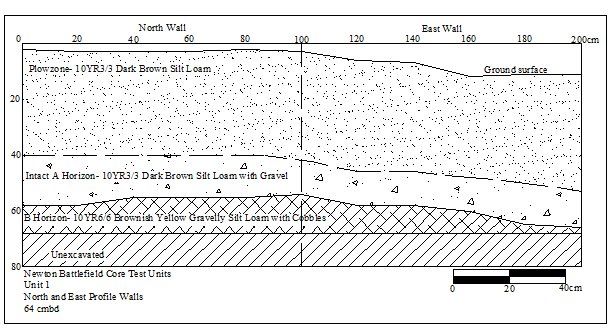
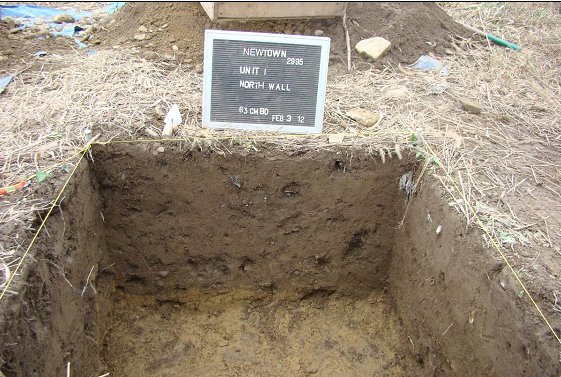


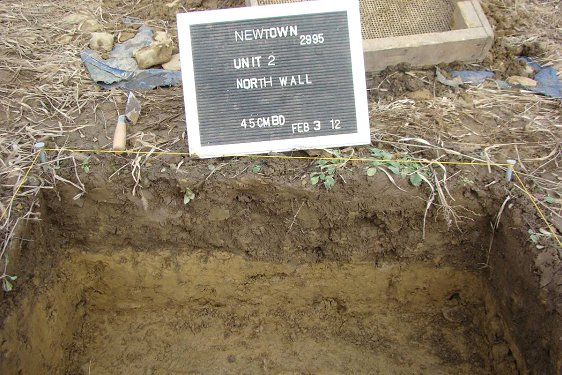
7.3 Features
Unit excavations revealed three possible archeological features. [text deleted] All of these features were identified in the boundary between the plowzone and the B soil horizon.
Feature 1 (Figure 22; Photo 17) consists of a clustering of ephemeral stains at the boundary of the plowzone and B horizon. Field crews identified the cluster of stains at a depth of 36 cm (14 in) below the surface. They consist of a very dark grayish brown (10YR3/2) silt loam that is set off from the surrounding brown (10YR3/3) silt loam. No artifacts were in association with the stains.
Feature 2 (Figure 23; Photo 18) is a well-defined soil stain on the east side of Unit 9. The stain consists of a very dark grayish brown (10YR3/2) silt loam adjacent to a brown (10YR3/3) silt loam. Field crews identified the stain at a depth of 50 cm (20 in) below the surface, just above the interface of the A and B soil horizons. The feature had a depth of approximately 3-4 cm (1 to 1.5 in) and most likely continued beyond the unit. One cut nail was found in proximity to the feature. The nail postdates the battle.
Feature 3 (Figure 24; Photo 19) consists of two adjacent patches of oxidized soil in Unit 8. Field crews identified the patches at a depth of 40 cm (16 in) below the surface directly at the interface of the plowzone and B soil horizon. The main oxidation patch consists of a reddish brown (5YR5/4) silt loam. The second patch consists of a brown (7.5YR5/4) silt loam. The second patch of oxidation's differing color may suggest that it was exposed to a lower temperature burn than the first one was. No artifacts were in association with the feature.
The features were generally positioned at the same elevation. Features 2 and 3 were identified at an elevation of 95.2 m and 95 m based on the site datum, respectively. Feature 1 was at an elevation of 95.7 m. [text deleted]
The function and cultural affiliation of the features is not evident. No artifacts specific to the Battle of Newtown were found in association with the features. No artifacts were found within the features. A definitive cultural association could not be determined.
There is some possibility that the features are associated with the British Ambuscade used during the Battle of Newtown. The features are in the same general location suggested by historical descriptions of the ambuscade. Major John Butler described the construction of the ambuscade as "On the 27th, we threw up some Logs one upon the other by way of a Breastwork...." (Flick 1929a:282). Colonel Thomas Proctor, Continental Chief of Artillery, described the ambuscade as "a breastwork of logs &c." (Parker 1903). The ambuscade was not a well-fortified structure, consisting of hewed logs covered with brush. The oxidation of Feature 3 and charcoal staining of Feature 2 and possibly Feature 1 are similar to the historical accounts that members of the Continental Army burned the British Ambuscade following the battle (Lt. Erkuries Beatty in Cook 1887: 27; Gen. John Sullivan in Cook 1887: 297). The ambuscade may have also been irregular with gaps and inconsistencies in the construction, especially the further away from the center of the line. If there were inconsistencies in the construction, then the burning would have also been somewhat irregular. The preservation of the remains of the ambuscade would have also been subject to the historic plowing of the related fields over the past 232 years. The deeper deposits along the bank of Baldwin Creek discussed in the previous section would have protected the remains of the ambuscade from plow dispersal.
The position of these features is also in alignment with the battle related materials recovered from the metal detector survey in the fields to the west of the unit testing area and to the east across Baldwin Creek (Figure 18). Although not definitive, the positions of the features correlate to clusters of musket/rifle balls suggesting the features may have been spatially related to the battle. If the stains do relate to the British Ambuscade, they may have served as a firing position along the British defensive line in which British, Loyalist, or most likely Native American warriors were firing towards, and received fire from the Continental troops. However, this does not mean that a large collection of battle related material would be found in the portions of the features uncovered. The features were not fully uncovered and reflect a decision to just sample the features. Historic descriptions claim that the firing along these lines was sporadic throughout the day (McNeill 1893:756). The sporadic nature of the firing would suggest that the battle related materials would be scattered across the lines with some probably clustering around firing positions. Those portions of the sampled ambuscade not directly associated with a firing position may not have related battle materials as it may not have been directly hit by fire. There is no certainty that musket/rifle balls would be found throughout the entire ambuscade.
There is no definitive evidence to associate these features to the battle, although secondary evidence (location and nearby clusters of lead balls) provides a possible relationship. The correlation of artifacts found in the area surrounding the features and the general spatial location and ephemeral structure of the features based on the historic descriptions of the British Ambuscade offer support that these features could possibly be the remains of a portion of the ambuscade. More extensive testing may provide information to either confirm or negate the association.
